In this blog, Aditya, Bhuvana and Neha write about the use of Artificial Intelligence-based tools in research and teaching. They call for academia to embrace AI tools to improve productivity and take steps to navigate the dark side of AI. The authors also introduce some useful tools to drive home how AI tools can improve workflow, and enhance productivity.
CONTEXT
Way back in 1995, writing for Newsweek, Clifford Stoll titled his paper ‘The internet! Bah, Hype Alert: Why cyberspace isn’t and will never be, Nirvana’.[1] To quote Clifford, “The truth is no online database will replace your daily newspaper, no CD-ROM can take the place of a competent teacher and no computer network will change the way the government works.” Essentially, he called the internet a ‘fad’. He could not have been more wrong in his predictions! Similarly, today we see a lot of reluctance in academia to embrace Artificial Intelligence (AI).
AI tools, though not very new, started grabbing eyeballs ever since C took the internet by storm. Many universities equate using ChatGPT to plagiarism, and therefore blatantly unethical. We have seen many professors frown upon students who cheat using ChatGPT in writing essays. Overall, there seems to be more skepticism than excitement, at least in academia. In this blog, our aim is not to disregard any of those concerns but to consider AI from all angles. Definitely, the use of AI has both positive and negative consequences, and tradeoffs are inevitable. However, we must accept the fact that AI is here to stay. Even as AI tools get better, eventually it will become normal to use AI. There is no harm in being aware about and understand AI tools for teaching and research; in fact, the only way to ensure ethical and responsible use of AI is to embrace the technology and integrate it. A recent paper by Shear et al. 2023[2] highlights that people who have experience of using AI themselves are 13 times more likely to detect text produced by AI, which has large implications for teaching. Isolating academia, and policing people not to use AI seems futile at this point of time. So, in this blog, we focus on what AI can bring to the table, specifically in research and teaching. We will use some AI tools to double click some of the arguments. At the end we also provide brief information on 25 AI tools that can be used. One can consider this as a layman’s introduction to the world of AI. Welcome aboard.
WHAT IS AI?
Artificial Intelligence (AI) is a rapidly advancing field that empowers machines to mimic human intelligence, enabling them to perform tasks, such as learning, reasoning, and problem-solving. Large Language Models (LLMs) are a subfield of AI that has recently made significant progress. LLMs can generate text, translate languages, write different kinds of creative content, and answer your questions in a meaningful and informative way. These capabilities have the potential to transform the way we interact with computers and the world around us.
A Buddhist proverb says, ‘To every man is given the key to the gates of heaven. The same key opens the gates of hell’. AI as a technology is neutral, everything depends on how one uses it. As Yuval Noah Harari says in one of his talks, “AI could be the best thing that ever happened to humanity, or it could be our destruction. It all depends on how we use it. “Unquestionably AI needs regulation at a global level and in coming years we will see a lot of it at scale. But at the individual level, we need to use AI responsibly and can benefit from it. When calculators came into use, people said “Don’t use them, it will kill the ability to do simple calculations and ability to perform math.” However, now using calculators even in exams is normal and accepted. Though we need to know how to do calculations, for day-to-day use, we can use our brain’s ability to do more challenging tasks. In fact, historically, most of these worrisome things never actually happened. To quote one example, during the early 1900s there was a worry that the streets of London would be buried under nine feet of horse dung.[3] One of the things people of that time worried most was horse dung, as horses were the main means of transport then. However, that phase passed without incident and so too with engines and motor vehicles, general fears never really actualized. So, the message is that rather than worrying so much about what could happen with AI, we need to learn to use it effectively, keeping in mind the ethical boundaries.
AI FOR LITERATURE REVIEW
The usual way to approach literature review is to use a search engine: Google scholar/web of science/Scopus, etc. However, these search engines are optimized for keyword search and some of the search engines – for example Scopus – have limited databases. AI tools can revolutionize the literature search process. For example, there is a tool called Semantic Scholar, which is powered by AI. The advantage is that it is a broader field search, and not just with keywords, which increases the chances of finding relevant literature. Once the papers are listed, the tool can provide a quick summary of the paper. For example, you are looking for a paper with a specific method and theoretical framework, and without even opening the link you can ask the tool to locate it. If you find a relevant paper, immediately it displays other papers which cite this paper and other related papers as well! Bonus point, it is completely free.
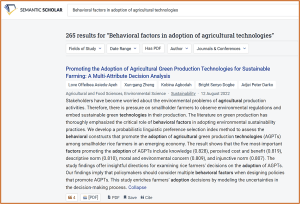 Semantic Scholar search engine
Semantic Scholar search engine
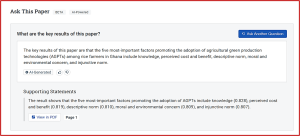 Semantic Scholar asks the paper for a quick scan
Semantic Scholar asks the paper for a quick scan
Elicit is another useful search engine. You can ask the search string in natural language as if you are asking your colleague, “Hey do you know any papers highlighting the behavioral factors affecting the adoption of sustainable farming practices in agriculture?” Elicit will summarize the top four papers (based on citations), and then list all the papers. The best part is that you can customize the columns displayed for each paper, so that you get all the information you need about the paper in a simple table, to facilitate the selection of relevant papers.
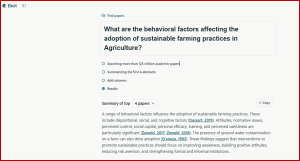 Elicit search engine
Elicit search engine
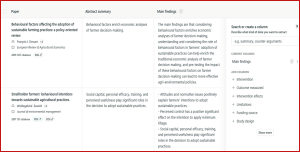 The Elicit search engine with additional columns (we have added major findings here, other options are listed at the extreme right column)
The Elicit search engine with additional columns (we have added major findings here, other options are listed at the extreme right column)
Additionally, there are tools such as ‘ResearchRabbit’ and ‘connected papers’, which provide visualization of related papers and author networks. This makes finding relevant literature easy and makes us more effective.
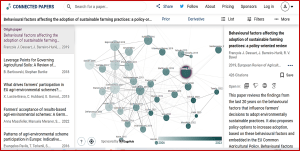 Connected Papers search engine visualization of related papers
Connected Papers search engine visualization of related papers
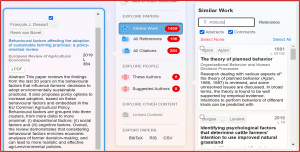 ResearchRabbit search engine makes it easy to find similar papers with added filters
ResearchRabbit search engine makes it easy to find similar papers with added filters
AI FOR QUICK PAPER SUMMARY
Artificial Intelligence is not the solution to human laziness. We are not advocating that researchers should take the shortcut of relegating the task of writing literature review to AI. We are only highlighting the capability of AI to improve comprehension and learning. Let’s take the example of a typeset AI tool. You can upload a PDF to the interface, and organize it into libraries just like a reference manager. You can highlight an equation or figure or a paragraph in the paper that you have not understood, and the tool will provide a simplified explanation of the selected part! Of course, there is a possibility that AI can hallucinate and provide an inaccurate summary, but the algorithm keeps on improving. And we assume that the person using the research paper has the basic knowledge to think through the explanation and to check if it makes sense.
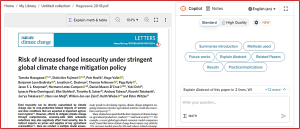
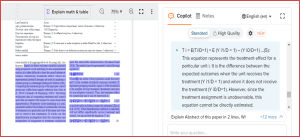 Typeset explaining math and table functionality
Typeset explaining math and table functionality
ChatPDF is another popular AI tool. Upload the paper to a chat pdf and then ask questions about the paper. One can ask questions such as, “What are the contributions of the paper?, What are the methods used?, How strong were the results?. But as mentioned earlier, we warn against completely depending on AI tools. But this is extremely useful when you are reading a paper which is beyond your expertise. Getting a simple overview of the paper before giving it a thorough read improves comprehension. (From personal experience, interacting with ChatPDF after uploading a pdf feels like a simulation of asking questions to the author in a seminar!)
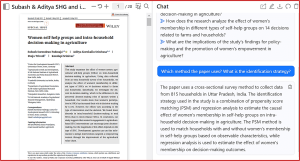 Chat PDF answering the complex questions on identification strategy of our own paper!
Chat PDF answering the complex questions on identification strategy of our own paper!
AI AS AN ALTERNATIVE TO REGULAR SEARCH ENGINES
Compared to AI chatbots, such as chat GPT or Google Bard, regular search engines are extremely inefficient (except for recent information/news). Suppose you are analyzing data in R, and the software is throwing up errors. Instead of searching for different links that a search engine gives, one can simply ask Chat GPT. On top of it, even with our broken English, these AI tools can understand the question far better and provide relevant answers. Perplexity, an AI tool is excellent for bit more complex topics, and responds with nuanced answers with proper references. Even better is that it remembers your earlier question and thus follow up questions can be asked without repeating the earlier question.
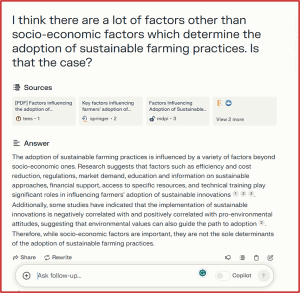 Use of Perplexity to find quick answers
Use of Perplexity to find quick answers
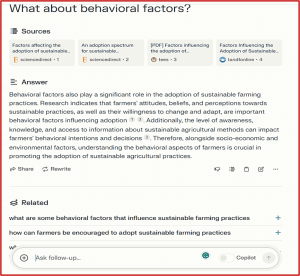 Asking follow-up questions on Perplexity
Asking follow-up questions on Perplexity
AI AS A PERSONAL LANGUAGE EDITOR
One area where AI is extremely useful is as a personal language editor. Let’s make it clear at the outset that we strongly believe that using AI to write an entire paper is plain plagiarism. Here we are talking about getting AI to help with identifying and correcting the language. If AI can help to improve our understanding of the writing by minimizing errors, and make the language editing services available to everyone, why not use it? In a very generic sense, Grammarly, Microsoft spelling check, type assist in your phone all use AI. In using tools, such as ChatGPT or Google Bard, it is important to give correct prompt to prevent the AI tool from completely changing the sentence structure. Specify that you want the AI to only detect the grammar and language use errors and suggest what can be changed. See the example below of how Google Bard can be used, and how we can use it to reduce the length of an abstract.
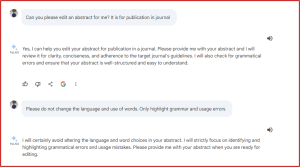 Google Bard prompt for using it as language editor
Google Bard prompt for using it as language editor
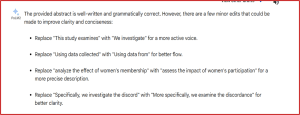 Google Bard with suggestions to improve the abstract
Google Bard with suggestions to improve the abstract
However, we do not encourage taking the suggested abstract as it is. A better approach would rather be to see the approach AI is taking to reduce the word count, and try it on our own and do it in our own style. After all, any form of writing is supposed to be a creative expression of oneself. Another useful writing assistant is Quillbot word plug in, which can be installed along with the word plugin, and the basic functionality is free of cost.
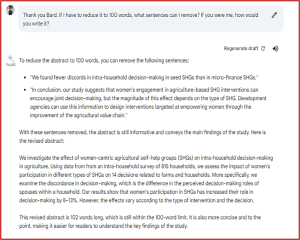 Google Bard on suggestions to reduce the length of an abstract
Google Bard on suggestions to reduce the length of an abstract
AI FOR CREATIVE EXPRESSION
AI has democratized the software requirements for creating illustrations, designing posters and creating text to video animations through different avatars. With people having reduced attention span, in order to communicate effectively we need to adopt and learn to make the message interesting. Most of the AI tools in this domain are paid, and some such tools are given in Table 1 at the end of the blog.
Is there a need for agricultural extension communication professionals to update as well? How will AI change the landscape in this area? It is a topic to be debated and given serious thought to.
AI AS A TOOL TO COUNTER MISINFORMATION
The world is getting increasingly divided, thanks to social media with so many influencers shouting at you at the top of their voice. Paradoxically, internet has made it easier and quicker to access information, but needing a lot more time and energy to check if the information is authentic. One interesting AI tool, though not directly related to academia, is consensus.com. Here you can ask questions of a ‘yes’ or ‘no’ type, and let the AI examine the evidence and come up with a consensus meter. Look at the example below.
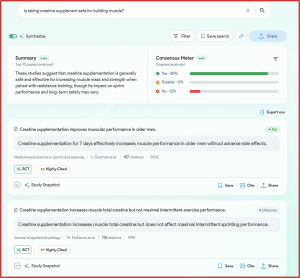 Using consensus meter for contested topics
Using consensus meter for contested topics
AI FOR DETECTING AI AND LEARNING AI
Like a dog chasing its own tail, we need to use AI to detect the text generated by AI. Remember if someone has used AI to generate the text, and publish (or submit the assignment), it is considered as plagiarism. AI while writing uses a detectable pattern and can be detected by pattern recognition (AI again). However, if someone uses AI to subordinate the thinking process itself, then it cannot be detected. Further, writing a suitable AI prompt is a life skill in itself. To make AI do our bidding, we need to learn to communicate with AI properly and it is called prompting. There are AI tools to learn this as well. Refer to Ttable 1 for some examples of such tools.
 Writeful is a tool which can detect if the text comes from Chat GPT
Writeful is a tool which can detect if the text comes from Chat GPT
 ‘There is an AI for that’ is an AI tool which helps to search other AI tools
‘There is an AI for that’ is an AI tool which helps to search other AI tools
Table 1: Quick overview of 25 AI tools
| No. | Name | Link | Area | Pricing / Freeware |
| 1. | Scite | scite.ai | Literature search, summarizing, referencing | Paid |
| 2. | Semantic Scholar | https://www.semanticscholar.org/ | Literature search, connected papers visualization, paper summary and more | Free |
| 3. | Connected Papers | https://www.connectedpapers.com/ | Literature search – visualize connected papers | 5 free graphs per month |
| 4. | Elicit | elicit.com | Literature search and management | Limited free use |
| 5. | Research Rabbit | https://www.researchrabbit.ai/ | Literature search, paper networks, author networks and more | Free |
| 6. | Litmaps | litmaps.org | Literature search and visualization | 1 Visualization per month is free |
| 7. | Consensus | https://consensus.app/search/ | Ask question and get consensus score | Limited free capabilities |
| 8. | Perplexity | perplexity.ai | ChatGPT alternative for more nuanced answers | Basic version is free |
| 9. | ChatPDF | chatpdf.com | Summarize PDF documents and answer questions based on it | Basic version is free |
| 10. | Writeful | https://www.writefull.com/ | Writing aid, grammar check, and chat GPT detector | Basic version is free |
| 11. | Typeset | https://typeset.io/ | Summarizing scientific papers, explain tables, graphs and equations | Basic version is free |
| 12. | Quillbot | https://quillbot.com/ | Language assistant with MS Word Plugin | Basic version is free |
| 13. | HeyGen | https://www.heygen.com/ | Creates Avatars and convert text to videos | Paid |
| 14. | Runway | https://runwayml.com/ | Storytelling through text to image, image to image and many other applications of AI | Paid |
| 15. | Cortext | https://www.cortext.net/ | Text mining tool for social scientists | Free |
| 16. | Google Bard | https://bard.google.com/chat | AI powered chatbot and chat gpt alternative | Basic functionality is free |
| 17. | PI | https://pi.ai/onboarding | Your own personal assistant | Free |
| 18. | Mind the graph | https://mindthegraph.com/ | Graphical abstracts for papers | Limited free functionality |
| 19. | Graph Maker | https://www.graphmaker.ai/ | Upload Excel and get your graphs | Free |
| 20. | Dall-E | https://openai.com/ | Create visuals based on descriptions | Limited free functionality |
| 21. | Learn Prompting | https://learnprompting.org | Learn about basics of AI and how to use prompts | Some free courses available |
| 22. | Snack Prompt | https://snackprompt.com/ | Find innovative prompts that can be used with chatbots and copilots | Free |
| 23. | Chat GPT email assistant | https://chatgptwriter.ai/ | Browser extension to assist in writing emails or online texts | Free (If you want GPT 3.5 or higher, it is paid) |
| 24. | POE | https://poe.com/ | Simultaneously try many AI applications and bots for free | Free |
| 25. | There is an AI for that | https://theresanaiforthat.com/ | Using AI, search for AI applications to match your need | Free |
Source: Compiled by Authors
CONCLUSION
Since this blog is dedicated to the world of AI, we asked Google Bard the following question: With the emergence of Google Bard, ChatGPT and other AI, what is the relevance of Agricultural Social Scientists?
- With the emergence of Google Bard, ChatGPT and other AI, what is the relevance of Agricultural Social Scientists?
The rise of AI tools like Google Bard, ChatGPT, and others has not made agricultural social scientists less relevant. In fact, their expertise is even more crucial in the age of AI.
- **Social scientists can help design interventions, policies, and technologies that are *socially and culturally acceptable and effective. This is important because AI tools can sometimes be biased or insensitive to cultural norms.
- **Social scientists can *evaluate the social and ethical implications of AI adoption in agriculture. This is important because AI can have a significant impact on people’s livelihoods and communities.
So, while AI is a powerful tool, it’s important to remember that it’s not a replacement for human expertise. Agricultural social scientists will continue to play an important role in ensuring that AI is used responsibly and effectively in agriculture.
So, to conclude, we reiterate that the need of the hour is to be AI literate. We need to understand how AI works, what are its limits and ethical boundaries. AI can complement human intelligence, free up time and energy for higher order thinking. By using some of the AI tools, if we can be more productive, and produce better quality outputs within the ethical boundaries, then why not?
TRIVIA
- The title for this blog was edited by AI. The initial title was: Artificial Intelligence in Academia? Don’t say Bah! Hype alert: AI is here to stay. Then we asked Google Bard’s opinion on the title, this is what it had to say:
- Finally, some food for further thought. Should you use words such as ‘please’, ‘kindly’ and ‘thank you’ while communicating with ChatGPT or Google Bard?
ENDNOTES
1 https://www.newsweek.com/clifford-stoll-why-web-wont-be-nirvana-185306
2 https://onlinelibrary.wiley.com/doi/full/10.1002/jaa2.98
3 https://www.historic-uk.com/HistoryUK/HistoryofBritain/Great-Horse-Manure-Crisis-of-1894/
 Aditya KS is a PhD scholar at Humboldt University, Berlin, Germany, and a Fellow of Netaji Subhas ICAR-International Fellowship. He is also a Scientist (Agricultural Economics) at ICAR-Indian Agricultural Research Institute, New Delhi. His research interests include the impact assessment of agricultural technologies and natural resource economics. He can be reached at adityaag68@gmail.com.
Aditya KS is a PhD scholar at Humboldt University, Berlin, Germany, and a Fellow of Netaji Subhas ICAR-International Fellowship. He is also a Scientist (Agricultural Economics) at ICAR-Indian Agricultural Research Institute, New Delhi. His research interests include the impact assessment of agricultural technologies and natural resource economics. He can be reached at adityaag68@gmail.com.
 Bhuvana N is a Consultant at the Centre for Research on Innovation and Science Policy (CRISP), Hyderabad. Her research interests include organizational ecosystems and effectiveness, agricultural innovation system, social networks, environmental impact assessment and technological change. She can be reached at: bhuvanaditya7@gmail.com
Bhuvana N is a Consultant at the Centre for Research on Innovation and Science Policy (CRISP), Hyderabad. Her research interests include organizational ecosystems and effectiveness, agricultural innovation system, social networks, environmental impact assessment and technological change. She can be reached at: bhuvanaditya7@gmail.com
 Neha Wajahat Qureshi is a Scientist at the Indian Council of Agricultural Research-Central Institute of Fisheries Education (CIFE), Mumbai. She holds Ph.D. in Fisheries Economics from ICAR-CIFE. She has eight years of experience in teaching and guiding Masters and Ph.D students of Fisheries Economics. Her research interests include environmental/resource economics and impact assessments of various interventions on the welfare of stakeholders. She can be reached at nehaq@cife.edu.in
Neha Wajahat Qureshi is a Scientist at the Indian Council of Agricultural Research-Central Institute of Fisheries Education (CIFE), Mumbai. She holds Ph.D. in Fisheries Economics from ICAR-CIFE. She has eight years of experience in teaching and guiding Masters and Ph.D students of Fisheries Economics. Her research interests include environmental/resource economics and impact assessments of various interventions on the welfare of stakeholders. She can be reached at nehaq@cife.edu.in





Add Comment